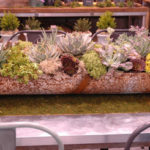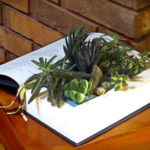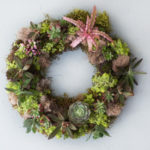How to Make Your Own Cork Planters
When it comes to interior design, do you fall for “Classic Elegance” or swoon over “Modern Eclectic” designs? No matter what your style is, co-authors Kylee Baumle and Jenny Peterson of Indoor Plant Décor: The Design Stylebook for Houseplants show you how to match the right plants with your interiors. Every style listed in the book’s chapters comes with a list of pertinent plants, containers, and even step-by-step DIY projects.
The cork planter tutorial in the video below is one of the book’s DIY projects. In the tutorial we used succulents, which author Baumle says are quite versatile in terms of style: “You can change their look just by changing the container you grow them in.” Find more tips on succulents (and photos) from Baumle and Peterson below.
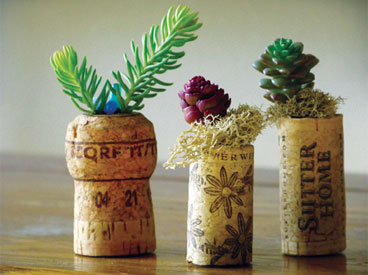
by Kylee Kylee Baumle and Jenny Peterson
After making the cork garden, we fell for the adorable succulents—hard. So, hoping to keep our tiny plants alive and strong, we asked the plant experts Kylee Baumle and Jenny Peterson, authors of Indoor Plant Decor, for tips.
Post Editors: How do you know if a succulent needs more (or less) water?
Kylee Baumle: Since succulents generally store moisture in their ‘leaves,’ when you see wrinkling, it means they need more water. In severe cases of underwatering, they’ll shrivel and fall off. The fatter the leaves, the more water they store, and the longer they can go without watering. If you start to see yellowing or the leaves turn black, that may indicate that you’ve overwatered.
PE: What about sunshine?
KB: Most succulents like full sun, but some, such as the jade plant (Crassula ovata), like bright, indirect light. Too much sun may cause browning, calloused-like places on the leaves.
Jenny Peterson: I experiment with lots of succulents inside, and I pay attention when I see one of them reaching for light and getting spindly. They’ll put out new growth that is longer without having any fullness to it, so that’s my clue to move it to a brighter locale.
PE: When does a succulent need a bigger pot?
KB: Repot when you see the roots growing through drainage holes.
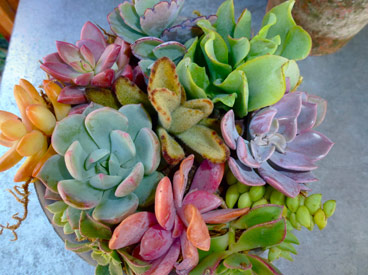
PE: If you’re putting several succulents into one pot, are there certain types of succulents that go together better than others?
KB: Most succulents will do fine placed together, but some are more tolerant of overwatering than others. Cacti, for example, are more sensitive to this and will experience root rot with too much water. Generally, if you like how they look together, then pot ’em up!
JP: I like to pair rounded, rosette forms (Echevaria, Aeonium) with succulents that trail, like Burro’s Tail (Sedum morganianum) or string of pearls (Senecio rowleyanus).
PE: Which succulents, if any, work best outdoors in your area?
KB: I’m in Ohio (Zone 5b/6a), and we can grow hens and chicks (Sempervivum); prickly pear cactus (Opuntia); and any number of sedums outside all year round. Any of the others can be grown outside in summer and brought inside for the winter.
JP: We can grow any succulent here in Austin, Texas (Zone 8b), but I make sure to give my outdoor succulents some afternoon shade. Our winters can be surprisingly cold here, too. So on the occasion when we expect a hard freeze, I cover mine up or bring them inside briefly.

PE: What steps should be taken to move an indoor succulent outdoors?
KB: When moving your succulents outside for the summer, treat them as if they were new baby seedlings. They’ll need “hardening off” by placing them in a semi-shady area that doesn’t get that harsh afternoon sun for a week or two before exposing them to full sun. Make sure the succulents you have can take full sun though, before putting them there. There are a few that will be happier in morning sun and afternoon shade or an area that has dappled sunlight throughout the day.
PE: Which of the styles in Indoor Plant Décor best describes you and your home décor? And which succulents suit your style?
KB: The style I like the best isn’t necessarily what I have in my home. Most of us don’t get the opportunity to start out with all new furniture and when we marry, our furnishings and style many times are a blend of what each spouse has or likes. Personally, our home is Traditional Mix, but if I could start from scratch, it would be Modern Eclectic.
JP: My house is definitely Modern Eclectic. I love some vintage elements mixed up with more contemporary pieces, but everything needs to be warm and inviting. I don’t like to have anything “matching,” so collected pieces are perfect for me. As for succulents, I love black aeoniums – the dark foliage with the light green centers are offbeat but elegant.
PE: What is your favorite succulent, and what are your tips for caring for it?

KB: My favorite succulent is the agave, which I have to grow as a houseplant because most of them aren’t hardy here. Their architectural form is classy and chic and they’re so easy to care for. Give them a bright window, make sure they’re planted in a well-draining medium in a pot with good drainage, and don’t overwater. I’d put them in the category of “no-care” plants, for the most part.
JP: I think I’d have to go with sedum. There are so many different types of sedum — ‘Blue Spruce’ looks like a tiny conifer, ‘Dragon’s Blood’ satisfies my need for some dark color, and ‘Americana’ is the easiest thing in the world to grow.
PE: And, finally, do you have any favorite plant or gardening jokes?
KB: You’ll be sorry you asked this! LOL! “What’s the difference between boogers and broccoli? Kids don’t eat broccoli.”
JP: Oh, Kylee, that is nasty! “Why do melons have fancy weddings? Because they cantaloupe.”

Kylee Baumle enjoys photographing gardens as much as she does tending to them. Her photos have been published in trade catalogs and garden magazines. She also writes for a number of gardening publications including Horticulture magazine, where she is also book review editor. Visit Kylee at her award-winning blog, Our Little Acre, where she writes and takes pictures of her growing experiences on her one-acre plot in rural Northwest Ohio.

Jenny Peterson is an Austin, Texas-based landscape designer and freelance writer specializing in xeriscaping and small urban spaces. Her design work has been featured in books, such as the vertical gardening book Garden Up! (Cool Springs Press) and Small-Space Container Gardening (Timber Press), and in gardening magazines. Jenny is a regional writer for Houzz.com and writes her blog, J Peterson Garden Design.
Check out Indoor Plant Decor: The Design Stylebook for Houseplants for more DIY plant projects and interior design ideas like the ones in the gallery below:

